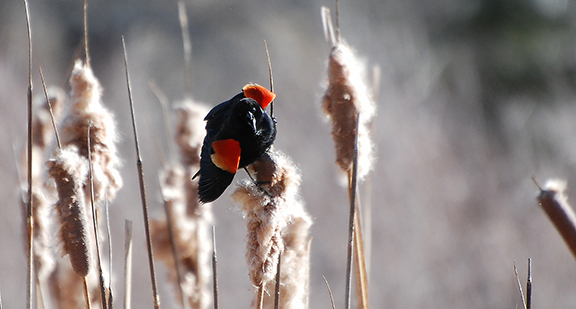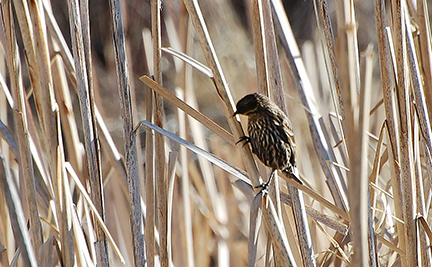Spring brings a raucous display to Glassier’s marsh

A male Red-winged blackbird displays its colors. Open Space and Trails photo
The outdoors has come alive with the sounds of bird life, but there may not be a noisier spot than the marsh at Glassier Open Space.
There, between the historic farmstead buildings and the Roaring Fork River, one inhabitant is central to the bedlam – the Red-winged blackbird. The cattail marsh is alive with these birds, though it’s the males that get all the notice. While the streaked-brown females go about the business of building nests low in the marsh reeds, multiple males spend much of their day proclaiming their territory, fending off intruders and showing off for their many female partners. It is quite a spectacle.
Red-winged blackbirds (Agelaius phoeniceus) are year-round residents of Colorado, though it is the males that tend to remain through winter while females generally head south. Springtime, however, is synonymous with this bird thanks to the antics and distinctive call of the males – a sound that has been described as “conk-la-ree” – two staccato bursts followed by the unmistakable trill of the “ree.”
Male Red-winged blackbirds are easily recognizable and this species is one of the most abundant in North America. Nonetheless, its status is of concern for conservationists because its numbers are in decline. Control measures (flocks can cause crop damage), habitat loss and climate change are cited as causes for the downward trend, according to the American Bird Conservancy.
These birds appear to be thriving at Glassier though, crowding the marshland and trilling from the flood-irrigated upper hay pasture. Bikers and hikers who are regular visitors to Glassier know exactly where to expect male blackbirds dive-bombing them on the trail. Birds as large as herons and raptors may face the wrath of a fearless Red-winged blackbird.
Red-winged blackbirds are polygynous, meaning the males share their territories with more than one female, while the females mate with opportunistic competitors despite a territory holder’s best efforts to fend off intruders. And, a male defending his territory is a display worth watching.
Perched atop a cattail, the bird hunches his shoulders forward, flares his tail, slightly spreads his wings and thrusts out his epaulets – patches of brilliant red feathers with a fringe of yellow on the lower margin. The body position accentuates the colors against the sheen of his jet-black wings and body. By one estimate, a male spends at least one quarter of the daylight hours striking this pose during breeding season, all while belting out the trademark trill. Outside of breeding season, males can nearly conceal the epaulets, helping keep the peace among flocks of these birds.
Breeding females may raise two or three clutches each season, building a new nest for each one and keeping the males busy well into the summer. That means there will be plenty of chances to see and hear them at Glassier in the months ahead.
Glassier Open Space reopens to recreation after its winter closure on May 1. The Glassier trails are open from dawn to dusk.
– By Pitkin County Open Space and Trails

A female Red-winged blackbird among the cattails at Glassier. Open Space and Trails photo
